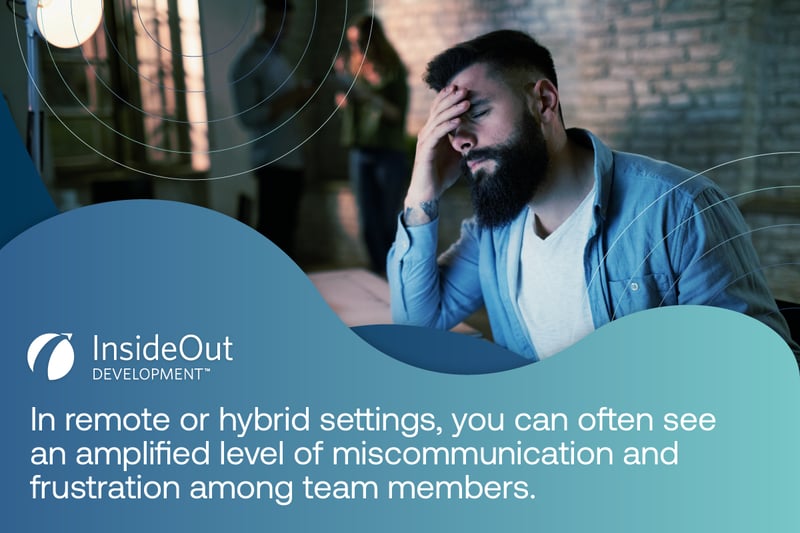Today, hybrid and remote teams have become the new norm. As we embrace the flexibility and advantages of remote work, it's important to be cognizant of the challenges that arise in managing teams scattered across different locations.
One of the key elements in successfully addressing the remote/hybrid work scenario is mastering the art of effective communication. By managing remote workers with kindness, understanding, and accountability, you increase the likelihood of building a great company culture with loyal and motivated employees.
In this blog, we'll delve into the dynamics of difficult conversations within hybrid and remote teams and explore the hurdles managers face when presented with a remote work setting. We’ll introduce a powerful and effective tool — the GROW® Model — to tackle these challenges and prepare you for any issues that may present themselves in the future.
Understanding the Dynamics of Difficult Conversations

Difficult conversations are an inevitable part of any relationship, especially those we have at work. However, relationships that don’t have daily face-to-face interaction — like in remote or hybrid settings — can see an amplified level of miscommunication and frustration among team members.
Communication barriers, such as time zone differences, varied work schedules, and unreliable computer or internet connections, can impact team dynamics significantly. In turn, learning how to manage remote workers properly becomes increasingly important.
When managing remote workers in larger organizations, the challenges are even more pronounced. This makes it even more important to identify and address issues before they escalate. Incorporating the GROW Model helps to alleviate any current issues and helps you communicate effectively with your remote team.
The GROW Model Approach for Managers
.png?width=800&height=533&name=Header_InsideOutGROWModelBlog_Canva%20(1).png)
GROW stands for Goals, Reality, Options, and Way Forward. The GROW Model is a structured approach that guides managers and leaders in addressing workplace issues, from problem-solving between team members to supporting every individual to perform optimally.
Beyond that, the GROW model also guides managers through difficult conversations by helping them communicate more effectively and resolve conflicts at the root of the problem. This is especially useful when barriers like remote and hybrid office settings pose extra difficulties.
Let's explore how this model can be applied to the unique challenges of remote and hybrid teams.
Goal Setting
In a virtual environment, defining clear objectives when addressing issues within a team is step number one.
Managers need to approach the problem — whatever it may be — with a clear agenda: How to address the issue, how to listen and provide support to your team when brainstorming for a solution, and then concluding how to best move forward.
Properly articulating the purpose of any discussion and setting expectations for the desired outcome helps individuals and even entire teams better align with overall goals.
This becomes particularly relevant when managing remote or hybrid workers. Team members may have different expectations of what their roles entail when working from home, or conflicts may arise due to miscommunication. By addressing frustration before it escalates into a full-blown problem, you’ll prevent workplace negativity and low-quality work.
Reality Checking
Assessing the current state of communication within the team is the next step. Managers of remote workers need to identify the specific challenges and roadblocks that hinder effective communication and help come up with solutions that work best for the entire team.
A great way to support your remote workers is to encourage an open dialogue about any problems or frustrations they’re experiencing and to talk about their overall remote work experience.
This helps to unearth issues that may not be immediately apparent in virtual interactions and gives your remote team a safe space to voice their concerns and address underlying problems before they get worse.
Options Generation
This step is an important one. The GROW Model promotes a culture of creative problem-solving; it considers the unique needs and preferences of remote team members without leaving anyone out.
Once you’ve identified the goal and your reality, it's time to brainstorm potential solutions collaboratively with the entire remote team. Many managers may forget to ask for feedback or simply haven’t taken the time to cultivate a sense of inclusivity. This makes for team members not feeling comfortable enough to voice their opinions or concerns.
On the other hand, when managers include everyone in the brainstorming process, it creates a sense of ownership among remote team members and helps them feel involved and indispensable, which often leads to improved team morale and a higher quality of work.
Way Forward
The next and final step involves developing a plan of action based on the generated ideas from the previous phase. Remote team managers need to gently enforce that each team member is accountable for implementing the necessary changes established in the brainstorming sessions.
Managers can guide their remote workers in this process by establishing clear timelines and positive reinforcement along the way. This proactive approach helps to prevent any current issues from escalating and promptly address any issues that may arise in the future.
Applying GROW to Various Types of Tough Conversations
The GROW Model can be applied to many types of difficult conversations, as it guides people to be authentic, curious, and accountable while delivering their message with kindness, understanding, and support.
Performance Feedback

Providing constructive feedback in a virtual environment requires a delicate touch. Since communication can be more difficult when done virtually, the GROW Model proves to be extremely helpful in these situations. It facilitates goal-oriented discussions, helping managers and team members align on their expectations through clear, actionable steps.
Addressing performance issues with empathy and clarity becomes more effective when both parties are actively involved in setting and understanding goals.
Utilizing technology for feedback sessions, whether through video calls or performance management tools, reinforces expectations and facilitates accountability for remote workers. Consistent virtual meetings help to manage remote workers effectively while also allowing for clearer and more personal connections.
Conflict Resolution

Facilitating virtual conflict resolution discussions becomes more effective when grounded in the structured approach of the GROW Model.
Conflicts are inevitable, but managing them within remote or hybrid teams requires a different approach. The GROW Model helps managers recognize and address conflicts right away as opposed to letting things simply play out on their own, which can often lead to extreme frustration within the team.
Strategies for successfully building and maintaining team cohesion are crucial for preventing and resolving conflicts. This could involve elements such as regular team-building activities, team brainstorming sessions, and creating designated times for open and honest communication.
Conflict resolution is not only wise — it’s essential for the well-being of your company and your remote team. Remember: Managing remote workers effectively means supporting them in whatever way they need and keeping them accountable, all while reinforcing the fact that they are an important part of the entire resolution process.
Team Collaboration

Promoting a culture of collaboration and inclusivity is fundamental to managing remote workers well. Trust is one of the most — if not the most — important elements to cultivate and doesn’t have to be complicated, even when dealing with physical distance and time barriers.
If you’re worried about how to engage remote workers, team activities prove to be a wonderful solution. Options include:
- Scheduling regular collaborative discussions
- Encouraging team members to voice their opinions
- Supporting remote workers to share their creative ideas
- Hosting weekly or monthly virtual get-togethers to facilitate connection
These methods ensure that everyone is actively involved in decision-making processes and feel included. This helps to strengthen communication and promotes team building for remote workers.
The Art of Communication

Mastering how to handle tough talks is a big accomplishment, especially when you're in charge of remote workers. It's important for the success of the company and also for the remote workers themselves.
If you're managing remote teams, the GROW Model helps create a culture where people can talk openly, understand each other better, and solve problems effectively. Doing this makes sure that both fully remote and hybrid teams can do well in today's changing work setup.
Whether you’re at home or in an office, being a leader in any setting is a privilege and responsibility. If you’re ready to gain the skillset necessary to become an effective leader, download this essential eBook and transform the way you manage and inspire those around you.





